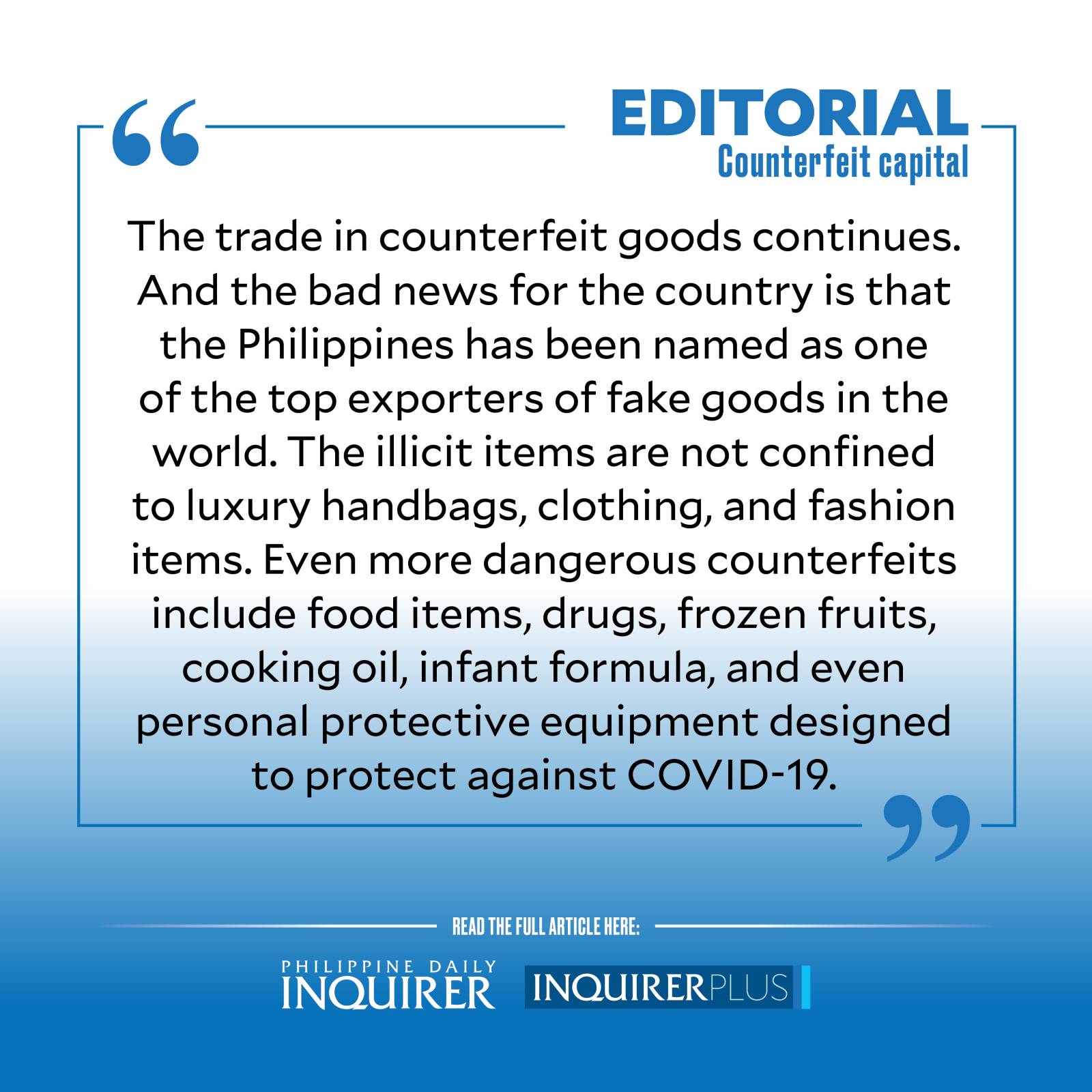Counterfeit capital

Some years back, in Seoul, tourists seeking “designer” goods at bargain prices would be led through a labyrinthine path to shops that sell these goods. The items, most of them handbags, were classified as “class A” reproductions for their quality and similarity to the real thing as compared to, say, items made in Bangkok or China.
But things have changed drastically in the last few decades. With authorities in Europe cooperating with the manufacturers of prestige designer products, international travelers tell of being confronted by customs officials who not only confiscate the contraband items, but also slash and cut them to make sure they are no longer usable or recognizable.
And yet the trade in counterfeit goods continues. And the bad news for the country is that the Philippines has been named as one of the top exporters of fake goods in the world. The illicit items are not confined to luxury handbags, clothing, and fashion items. Even more dangerous counterfeits include food items, drugs, frozen fruits, cooking oil, infant formula, and even personal protective equipment designed to protect against COVID-19.
The European Union Intellectual Property Office (EUIPO) and the Organization for Economic Cooperation and Development (OECD) conducted studies based on data from 2017 to 2019. A 2022 study titled “Dangerous Fakes: Trade in Counterfeit Goods that Pose Health, Safety and Environmental Risks” ranked the Philippines 13th globally as the source of dangerous counterfeits.
“Dangerous counterfeits” are defined as fakes which pose risks to health, safety, the environment, and personal security.
According to a news report, “in terms of origin countries for dangerous counterfeit food products within the same period, the Philippines ranked fourth globally, just behind China, Hong Kong and Turkey.” The study also found that the country ranked 15th among countries where dangerous fakes purchased online come from.
But back to fake fashion. A study conducted by the EUIPO and OECD titled “Global Trade in Fakes: A Worrying Threat,” found the Philippines—just behind China, Hong Kong, Turkey, Singapore, and the United Arab Emirates (which together accounted for 90 percent of global seizures)—as a source of fake leather articles and handbags. The study further found that the Philippines held a significant share of seized value and trade flow in the export of fake perfumes, cosmetics, footwear, toys and games, jewelry, and clothing.
One mall in particular has been targeted for the unabated sale and display of fake fashion items. A report released by the United States Trade Representative last year identified Greenhills Shopping Center, which is found in San Juan City in Metro Manila, as among the world’s 35 physical markets known for counterfeiting and piracy. Indeed, Greenhills has been the subject of periodic raids by authorities, with one such operation yielding P63 million worth of counterfeit items. For its part, the shopping center’s management vowed to work with the government, and offered to provide an office for the staff of the National Committee on Intellectual Property Rights to promote intellectual property rights protection.
Laudable as it may be, the action seems to be a case of “too little, too late,” since the trade in counterfeits is not only decades old; it is brazen and bold as well.
Still, the Intellectual Property Office of the Philippines (IPOPHL) is seeking to go beyond Greenhills by reaching out to every barangay to implement an antipiracy policy, in compliance with a memorandum issued by the Department of the Interior and Local Government. Part of the effort is to get local governments to issue an ordinance to ban the sale, transfer, manufacture, and/or production of pirated, counterfeit, and fake goods. “One thing we look forward to from this circular is speeding up the process in enforcement,” said IPOPHL deputy director general Teodoro Pascua. “The frontline here is really in the local government, down to the barangays.” Similarly, the buying public has helped this notorious trade flourish.
The sale of fakes may seem harmless and trivial, but according to EUIPO executive director Christian Archambeau, it has more far-reaching consequences. “It damages economic growth; poses significant threats to individual and collective health and safety; fuels organized crime; undermines sound public governance, the rule of law, and citizens’ trust in government.”
So, the next time you might be tempted to succumb to the lure of fakes, keep in mind that your money isn’t only financing criminal syndicates or encouraging shoddy, if not dangerous, practices. It also harms whole economies and a country’s reputation.




















